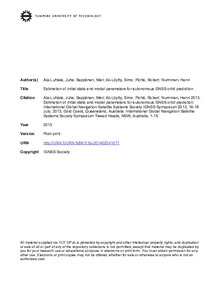Estimation of initial state and model parameters for autonomous GNSS orbit prediction
Ala-Luhtala, Juha; Seppänen, Mari; Ali-Löytty, Simo; Piche, Robert; Nurminen, Henri (2013)
Ala-Luhtala, Juha
Seppänen, Mari
Ali-Löytty, Simo
Piche, Robert
Nurminen, Henri
IGNSS Society
2013
Julkaisun pysyvä osoite on
https://urn.fi/URN:NBN:fi:tty-201402041071
https://urn.fi/URN:NBN:fi:tty-201402041071
Kuvaus
Peer reviewed
Tiivistelmä
In self-assisted GNSS the orbit of a satellite is predicted by solving the differential equation that models its motion. Our motion model includes the most important forces: Earth's gravity, lunar and solar gravity and solar radiation pressure. Unmodeled forces are taken into account by using Gaussian white noise term with covariance matrix estimated offline from historical orbital data. The estimation of model parameters (solar radiation pressure and Earth orientation parameters) and initial state for the prediction includes both offline and online stages. In the offline stage, priors for the solar radiation pressure parameters are estimated using precise orbits issued by the International GNSS service (IGS). In the online stage, the satellite’s broadcast ephemeris is used to estimate the initial state and model parameters. The estimation of the initial state is formulated as non-linear continuous-time filtering problem with discrete-time measurements. The filtering equations are solved numerically and the performance of different numerical methods (Extended, Cubature and Unscented Kalman filters) is compared. Using the estimated initial state and model parameters, the satellite orbits are predicted 5 days into the future. The accuracy and consistency of the predicted orbits is analysed by comparing with the IGS precise ephemerides. In this paper only GPS satellites are considered, but the method can be extended to other satellite systems.
Kokoelmat
- TUNICRIS-julkaisut [16929]
